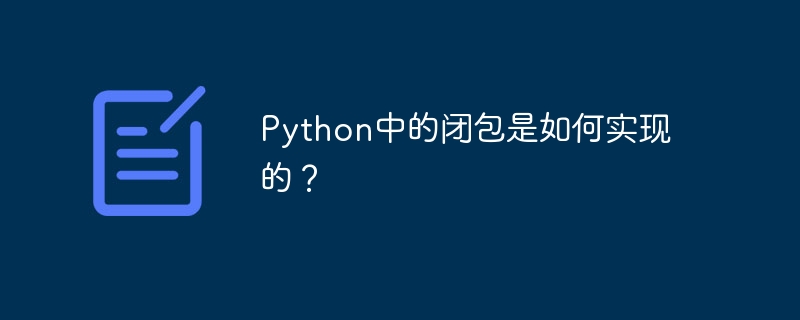

How is closure implemented in Python?
A closure is a function defined inside a function, and the variables of the external function are referenced inside the function. This feature allows the inner function to access the variables of the outer function, and after the outer function has completed execution, the closure can still access and operate the variables of the outer function.
Closures are implemented in Python through the following steps:
Define the outer function and define the inner function inside it: First, we need to define the inner function inside the outer function Define an internal function. This inner function is the closure.
def outer_function(): # 定义内部函数 def inner_function(): pass
Inner function references the variables of the outer function: In the inner function, we need to reference the variables of the outer function. You can use the variables of the external function as parameters of the internal function or use the variables of the external function directly inside the internal function.
def outer_function(): # 外部函数的变量 x = 10 # 定义内部函数 def inner_function(): # 引用外部函数的变量 print(x)
Return the inner function: In the outer function, return the inner function as the return value.
def outer_function(): # 外部函数的变量 x = 10 # 定义内部函数 def inner_function(): # 引用外部函数的变量 print(x) # 返回内部函数 return inner_function
Call external functions to generate closures: Generate closures by calling external functions. At this point, the inner function references the variables of the outer function, and can continue to access and operate on these variables after the outer function has completed execution.
def outer_function(): # 外部函数的变量 x = 10 # 定义内部函数 def inner_function(): # 引用外部函数的变量 print(x) # 返回内部函数 return inner_function # 调用外部函数,生成闭包 closure = outer_function()
Through the above steps, we have successfully implemented closures in Python. At this point, we can access and manipulate the variables of the external function by calling the closure.
closure() # 输出:10
An important feature of closures is that after the external function completes execution, the closure can still access and operate the variables of the external function. This is because the closure retains a reference to the outer function variable instead of copying the variable's value. Therefore, we can observe the behavior of a closure by calling it multiple times.
def outer_function(): # 外部函数的变量 x = 10 # 定义内部函数 def inner_function(): # 引用外部函数的变量 print(x) # 返回内部函数 return inner_function # 调用外部函数,生成闭包 closure = outer_function() closure() # 输出:10 # 修改外部函数的变量 outer_function.x = 20 closure() # 输出:20
Through the above code, we can see that the closure will output the variables of the external function when called. Even after the external function completes execution, the closure can still access and operate the variables of the external function.
The implementation of closure in Python is simple and clear. Through the mechanism of function nesting and referencing external variables, the function has memory ability and persistence. This is one of the reasons why closures are widely used in Python.
The above is the detailed content of How are closures implemented in Python?. For more information, please follow other related articles on the PHP Chinese website!




